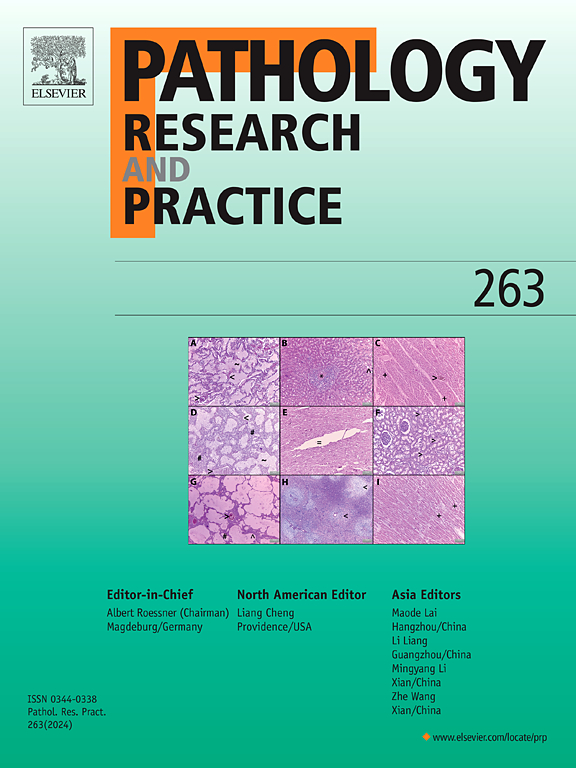东亚人群胆道癌TERT启动子突变的临床病理和基因组特征。
IF 2.9
4区 医学
Q2 PATHOLOGY
引用次数: 0
摘要
端粒酶逆转录酶基因启动子(TERT)突变是预测各种恶性肿瘤患者生存和免疫检查点抑制剂反应的生物标志物。然而,它们在胆道癌中的患病率和临床病理特征在很大程度上是未知的。我们使用下一代测序技术对来自485例癌的福尔马林固定石蜡包埋肿瘤组织进行了全面的基因组分析,包括肝内(n = 220)、门周(n = 54)、胆道远端(n = 110)和胆囊(n = 101)癌。在485例胆道癌中,有50例(10.3 %)观察到TERT突变,包括39例C228T(78.0% %)和11例C250T(22.0% %)变异。在不同的解剖位置中,TERT突变在胆囊最常见(20.8 %),其次是肝门周围(9.3 %),肝内(7.7 %)和胆管远端(6.4 %)本文章由计算机程序翻译,如有差异,请以英文原文为准。
Clinicopathologic and genomic characteristics of biliary tract carcinomas with TERT promoter mutations among East Asian population
Telomerase reverse transcriptase gene promoter (TERT) mutations are biomarkers that predict survival and responses to immune checkpoint inhibitors in various malignancies. However, their prevalence and clinicopathologic characteristics in biliary tract carcinomas are largely unknown. We performed a comprehensive genomic profiling of formalin-fixed paraffin-embedded tumor tissue from 485 carcinomas, including intrahepatic (n = 220), perihilar (n = 54), distal biliary tract (n = 110), and gallbladder (n = 101) cancers, using next-generation sequencing. TERT mutations were observed in 50 out of 485 biliary tract cancers (10.3 %) consisting of 39 C228T (78.0 %) and 11 C250T (22.0 %) variants. Among the different anatomic locations, TERT mutations were most frequent in the gallbladder (20.8 %), followed by perihilar (9.3 %), intrahepatic (7.7 %), and distal bile ducts (6.4 %) (p < 0.01). Genetically, TERT mutations were significantly associated with TP53 mutations (p = 0.04), ERBB2 amplification (p < 0.01), and high tumor mutational burdens (TMB) (p < 0.01); moreover, they were negatively correlated with KRAS (p < 0.01), SMAD4 (p = 0.01), and PBRM1 mutations (p = 0.01). In addition, TERT mutations were associated with a poor progression-free survival (PFS, p = 0.01). Specifically, in cases of intrahepatic cholangiocarcinoma, TERT mutations were more frequent in patients with cirrhosis (p = 0.01), hepatitis B virus infection (p = 0.04), and advanced disease stages (p < 0.01). In gallbladder carcinoma, TERT mutations were also associated with poor PFS. In conclusion, TERT mutations in biliary tract carcinomas had unique clinicopathologic and genetic characteristics. Despite its poor PFS, the concomitant presence of ERBB2 amplification and a high TMB indicated a potential for targeted therapy and immunotherapy in this specific subtype.
求助全文
通过发布文献求助,成功后即可免费获取论文全文。
去求助
来源期刊
CiteScore
5.00
自引率
3.60%
发文量
405
审稿时长
24 days
期刊介绍:
Pathology, Research and Practice provides accessible coverage of the most recent developments across the entire field of pathology: Reviews focus on recent progress in pathology, while Comments look at interesting current problems and at hypotheses for future developments in pathology. Original Papers present novel findings on all aspects of general, anatomic and molecular pathology. Rapid Communications inform readers on preliminary findings that may be relevant for further studies and need to be communicated quickly. Teaching Cases look at new aspects or special diagnostic problems of diseases and at case reports relevant for the pathologist''s practice.

 求助内容:
求助内容: 应助结果提醒方式:
应助结果提醒方式:


